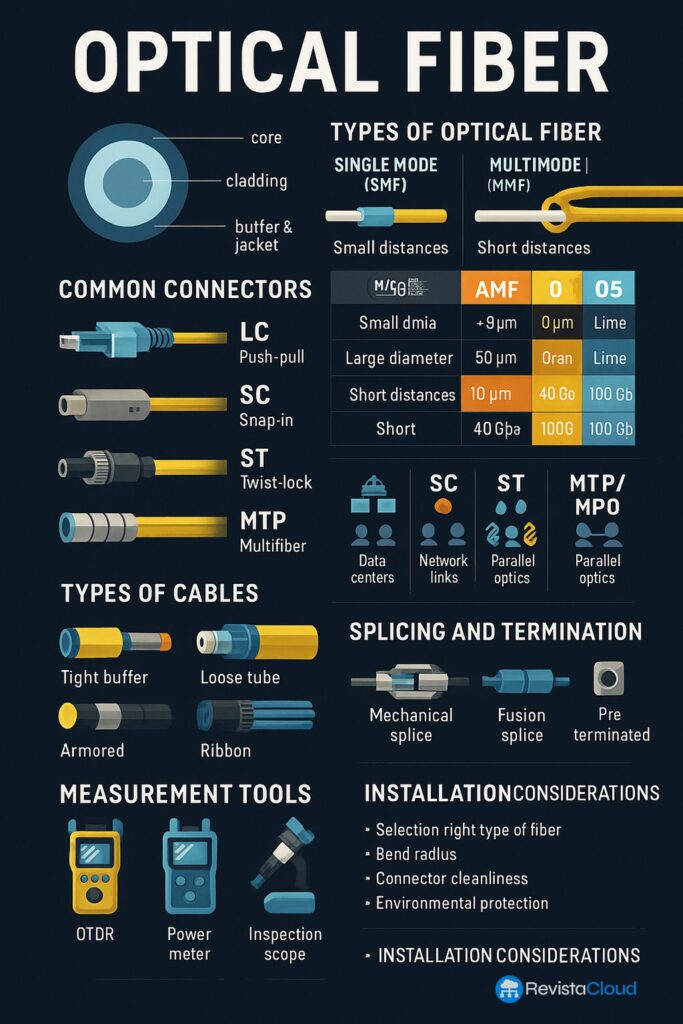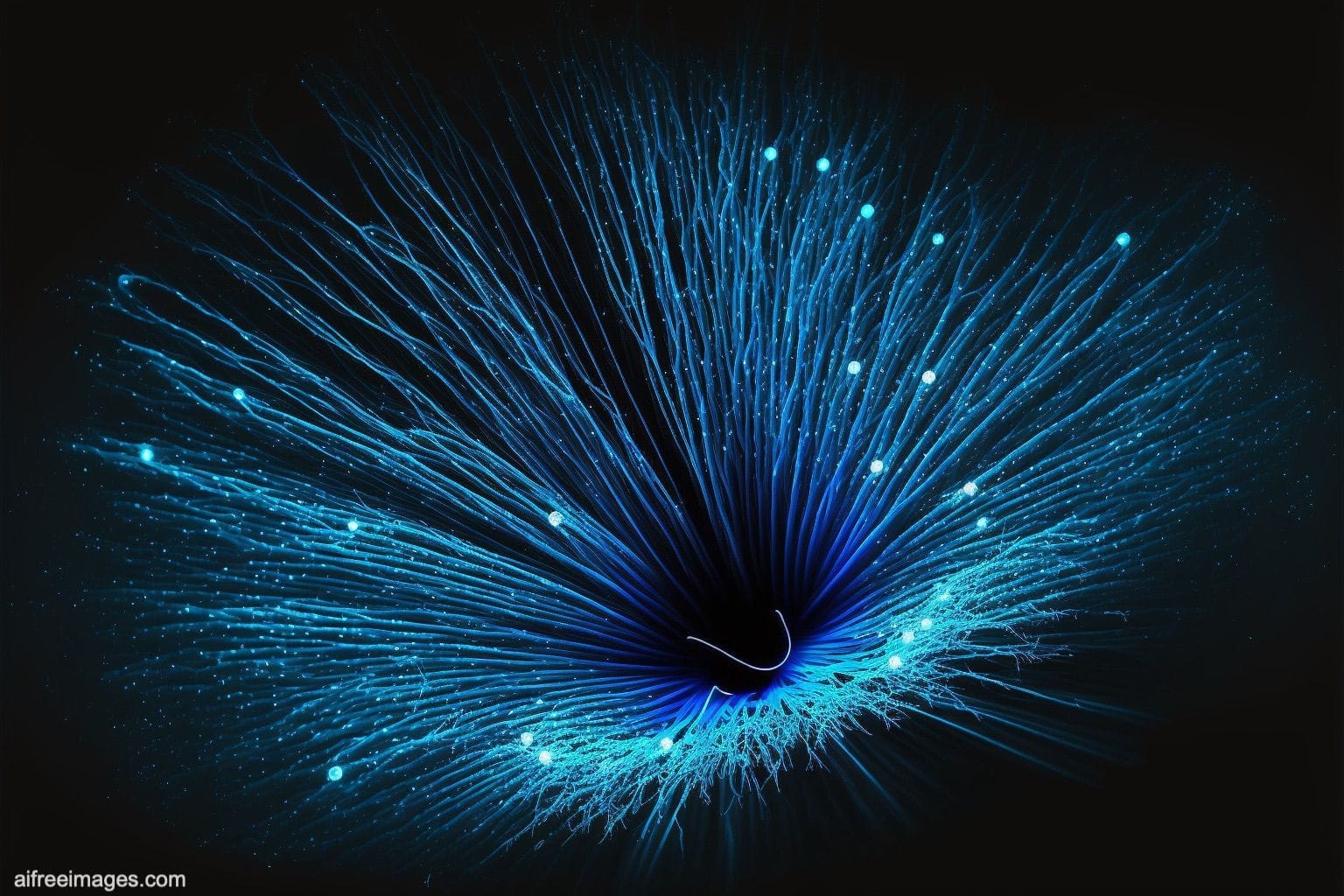In the era of hyperconnectivity, fiber optics has established itself as the fundamental pillar of telecommunications infrastructure. Its capacity to transmit large volumes of data at speeds close to the speed of light, with low latency and almost total immunity to electromagnetic noise, makes it the best option for long-distance networks, data centers, enterprise backbones, and FTTH (Fiber To The Home) networks.
This article delves deeply into the types of fiber optics, their applications, common connectors, current standards, and technical considerations for deployment.
What is fiber optics?
Fiber optics is a transmission medium composed of glass or plastic threads capable of conducting pulses of laser or LED light that represent digital data. Its basic structure consists of three layers:
- Core: where the light travels.
- Cladding: surrounds the core and enables total internal reflection.
- Protective coating: protects against moisture, dust, and mechanical stress.
Types of fiber optics
1. Single Mode Fiber (SMF)
- Standard jacket color: yellow
- Core: ~9 microns
- Advantage: transmits laser signals over long distances without dispersion.
- Typical uses: metropolitan links, backbones, telecommunications, datacenter interconnections.
- Common standards: OS1 (up to 10 km), OS2 (up to 40 km or more)
2. Multi Mode Fiber (MMF)
- Common colors: orange (OM1/OM2), aqua (OM3/OM4), lime green (OM5)
- Core: 50 or 62.5 microns
- Advantage: cheaper than SMF, compatible with LED and VCSEL sources.
- Disadvantage: greater modal dispersion, limited to shorter distances.
- Typical uses: internal building wiring, datacenters, racks.
- Standards:
- OM1: 62.5/125 µm, up to 1 Gbps
- OM2: 50/125 µm, up to 10 Gbps (82-300m)
- OM3: optimized for laser, up to 10 Gbps (300 m) or 40/100 Gbps (100 m)
- OM4: up to 550 m at 10 Gbps, 150 m at 100 Gbps
- OM5: designed for wavelength multiplexing (SWDM), up to 400 Gbps
Most Common Types of Connectors
Connectors are critical for optical continuity and network efficiency. Among the most widely used:
| Connector | Coupling Type | Most Common Use |
|---|---|---|
| LC | Push-pull, small | Datacenters, high density |
| SC | Snap-in | Network links and FTTH |
| ST | Twist-lock | Older installations and educational settings |
| MTP/MPO | Multi-fiber connector | Parallel connections 40/100/400G |
Note: all these connectors can have UPC (Ultra Physical Contact) or APC (Angled Physical Contact) terminations. APC offers better return loss values (ideal for video or long-distance links).
Types of Fiber Optic Cables
Depending on the installation environment, different types of cables are used:
- Tight buffer: ideal for indoors, more flexible and easier to install.
- Loose tube: typical for outdoors and conduits, more resistant to water.
- Armored: with metallic protection against rodents or impacts.
- Breakout cables: with individual reinforced fibers, easy to terminate.
- Ribbon fiber: 12 or 24 parallel fibers, for mass splicing.
Connections and Splices
a) Mechanical Splice
- Fiber is manually aligned.
- Lower cost, higher loss (0.3-0.75 dB).
b) Electric Arc Fusion (Splicing)
- Permanently fuses cores.
- Minimal losses (<0.1 dB), high precision.
- Requires a fusion splicer, more commonly used in backbone and metropolitan networks.
c) Pre-Terminated Connectors
- Prefabricated and polished connectors.
- Commonly used in datacenters and modular environments.
Testing and Maintenance
To ensure the performance of a fiber optic network, tools such as:
- OTDR (Optical Time Domain Reflectometer): measures losses, distances, and locates faults.
- Power Meter & Light Source: measures optical power at each end.
- Inspection Microscope: verifies cleanliness and quality of the connector.
Connector cleanliness is critical. Seventy percent of optical network problems are due to dirty or poorly polished connectors.
Key Considerations in Design and Installation
- Appropriate fiber type (SMF vs MMF) based on distance and bandwidth.
- Consistent connector type and color coding.
- Path management and minimum bend radius to avoid losses.
- Protection against rodents, moisture, and fire.
- Optical budget calculation: to avoid exceeding maximum attenuation.

Fiber optics is a mature technology but in constant evolution, capable of supporting speeds over 800 Gbps in current deployments. From FTTH networks to trunk links between datacenters, fiber optics stands as the gold standard in high-speed connectivity.
Mastering types, connectors, splicing methods, and maintenance techniques not only allows for deploying more efficient networks but also ensures their availability and long-term performance.

